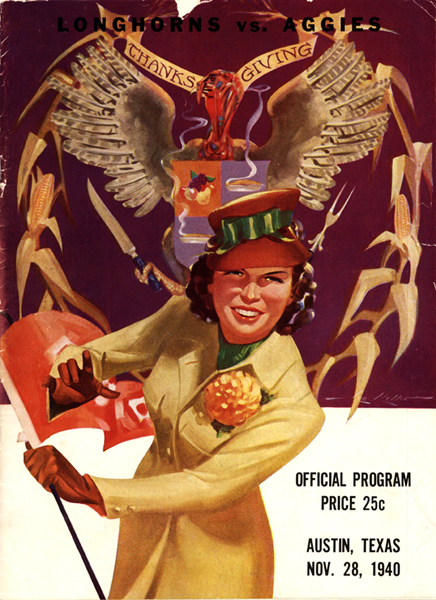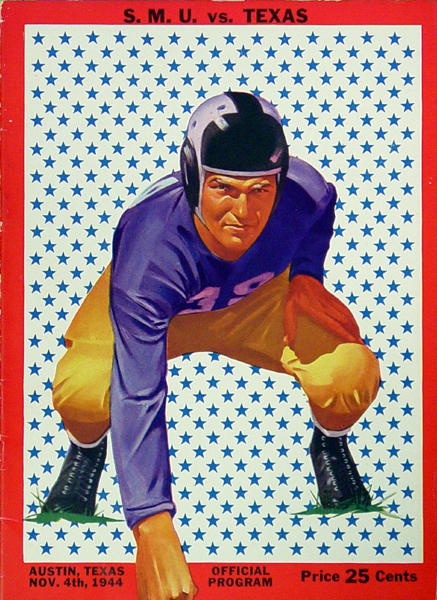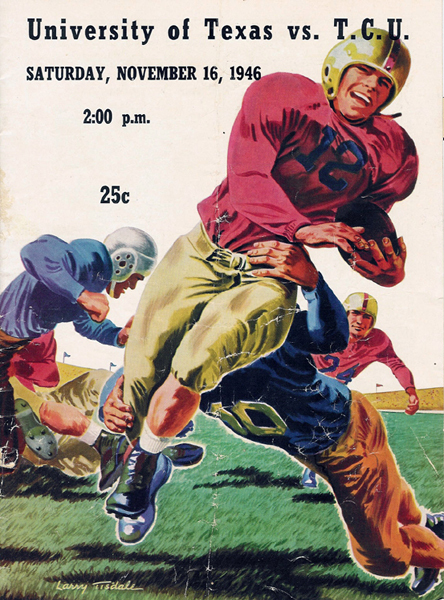1940-1949
The 1940 Thanksgiving Day program for the annual battle with the Aggies begins a trend of using "franchised" cover art for nearly all the home and away game programs. While artist Lon Keller's woman is vibrant and skillfully drawn-and the turkey imitating the American eagle seal undoubtedly caused a chuckle or two-the purple background, red banner and lack of anything uniquely Texan makes it hard to distinguish this cover from those at any other college in the country. However, although not locally produced, these 1940 program covers still tell important tales, the first of which is the increasing role of women as fans and participants in the football experience. Throughout the 1940s, Keller and other syndicated artists (such as Larry Tisdale) used women to put a glamorous face on football. In keeping with magazine cover art of this era, the image of the vivacious, well-groomed young woman-the slightly-sexy girl-next-door-had become a marketer's dream. Putting a "pretty girl" on the cover of anything helped it sell in the 1940s, and with thousand of American men away from home during World War II, the female covers were a way to suggest that women could also be paying fans at football games.
The other major story reflected by the covers of the 1940s, of course, was World War II itself. With Dana X. Bible at the helm of the football program, the Longhorns stayed on course in the early 1940s, despite the fact that America entered World War II after the bombing of Pearl Harbor on December 7, 1941. Bible's 1941 team posted the best record ever for the Longhorns, ending the season 4-1-1, and ranked at No. 4 nationally. His team was featured on the cover of Life magazine that year, and in the war years that followed, Bible managed to keep the Longhorns near the top, winning the SWC title in 1942, 1943 and 1945, and placing 11th, 14th, and 10th in the national rankings. He retired from football in 1946 following an 8-2 record, but remained the athletics director through 1956.
Football program covers from the war years all display patriotic themes. Whether this would have been true if they had been locally produced is unknown, but the commercial agencies supplying syndicated art were clearly behind the American forces. Red, white and blue colors predominate, and stars, stripes, eagles and, of course, flags filled the backgrounds of nearly every program. During the war, these patriotic devices spoke a language known to all Americans. The eagle symbolized both the country and our courage. Red was symbolic of the blood spilled in the war, white was a symbol of hope and peace. The blue stars of the 1944 SMU program may look to modern viewers as simply the artist's desire to use blue stars. However, anyone sitting in the stands of Memorial Stadium in the 1944 would have known that the blue stars represented the University's own "Sons in Service." During World War II, families with a son on active duty would hang a government-sponsored "Sons in Service" flag in a prominent window in their home. On the flag, a blue star in the center of a red-bordered white rectangle signified the serviceman. If the serviceman died in action, the star's color was changed to gold to signify that the family had lost a son or family member in the war.
Following the war, the University and America entered a new and euphoric era. Blair Cherry, who'd been Bible's assistant for nearly a decade, took over the head coaching duties and reaped the benefits of both Bible's recruiting and the GI Bill (which allowed many older servicemen to enter college for the first time). With Bobby Layne as quarterback, Cherry's 1947 team went 10-1 for the season and beat Alabama in the Sugar Bowl. His 1948 team went 7-3-1 and won the Orange Bowl. Though his 1949 team managed only a 6-4 year, the 1950 team went 9-2 and 6-0 in SWC, but then lost to Tennessee in the Cotton Bowl.
The optimism of the post-war years is also reflected in the surviving football programs from that era. The smiling girls and warm, fuzzy cocker spaniel all suggest hearth, home and happiness. The baby boom had arrived. One of the more interesting covers of the post-war years is Larry Tisdale's 1946 TCU program illustration. Devoid of both patriotism and smiling women, the cover puts the focus clearly on the combative nature of the game. Here, Tisdale has drawn muscular men-not boys-symbolic of the return of the GI to the gridiron and the new emphasis on manliness that pervaded popular culture after World War II.





